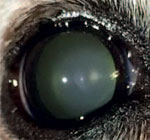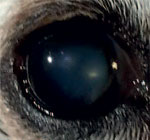Researchers recently discovered that the molecule lanosterol can dissolve the lens protein buildup that causes cataracts.
“Cataract surgery is the most common operation performed in the United States,” says Eric Donnenfeld, MD, the national medical director of TLC Laser Eye Centers. “The only treatment for this common disorder is surgery, but for years scientists have been looking for a medical therapy to either prevent or treat cataracts.”
This new finding by Ling Zhao, PhD, and colleagues holds promise for just such a therapy. They found treatment with lanosterol “significantly decreased preformed protein aggregates both in vitro and in cell-transfection experiments” and “could reduce cataract severity and increase transparency in dissected rabbit cataractous lenses in vitro and cataract severity in vivo in dogs,” the researchers write in the journal Nature.
  | |
| At left, a cataractous dog lens. At right, the same lens treated with lanosterol with increased lens clarity. Photos: Zhao, et al. |
They came across the discovery while studying a family in which three of four children have cataracts, although neither parent does. They found the children with cataracts had a mutated version of a gene that’s involved in the production of lanosterol. The researchers then conducted several tests with lanosterol, ultimately uncovering its ability to inhibit lens protein aggregation and reduce cataract formation.
The next step in the research process is designing human trials. The researchers expect the use of lanosterol in humans to have little toxic effect, considering it is a molecule produced naturally by the human body. And while a commercially available treatment is likely far in the future, the finding holds promise for the growing cataract population.
“Our study identifies lanosterol as a key molecule in the prevention of lens protein aggregation and points to a novel strategy for cataract prevention and treatment,” the authors conclude.
“This paper offers a promising new therapy in the treatment of cataracts,” Dr. Donnenfeld says. But “our enthusiasm should be tempered by the knowledge that other compounds have been tried in the past and have not been effective. I look forward to further research in this area and remain hopeful that a medical therapy will emerge that will help millions of patients.”
Zhao L, Chen XJ, Zhu J, et al. Lanosterol reverses protein aggregation in cataracts. Nature. 2015.
